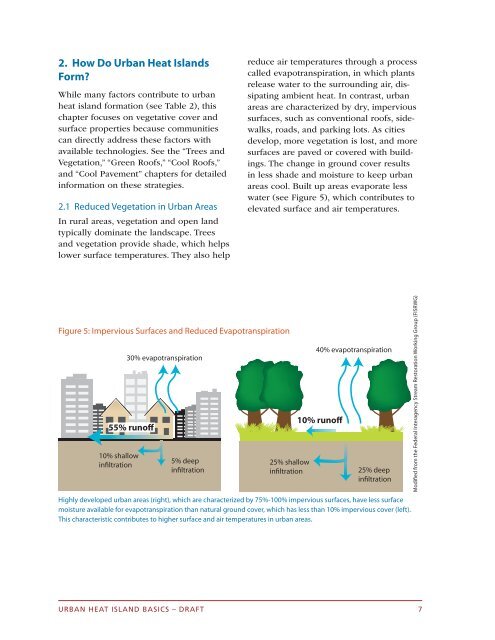Urban Heat Island Basics - US Environmental Protection Agency
Urban Heat Island Basics - US Environmental Protection Agency
Urban Heat Island Basics - US Environmental Protection Agency
Create successful ePaper yourself
Turn your PDF publications into a flip-book with our unique Google optimized e-Paper software.
2 . How Do <strong>Urban</strong> <strong>Heat</strong> <strong>Island</strong>s<br />
Form?<br />
While many factors contribute to urban<br />
heat island formation (see Table 2), this<br />
chapter focuses on vegetative cover and<br />
surface properties because communities<br />
can directly address these factors with<br />
available technologies. See the “Trees and<br />
Vegetation,” “Green Roofs,” “Cool Roofs,”<br />
and “Cool Pavement” chapters for detailed<br />
information on these strategies.<br />
2.1 Reduced Vegetation in <strong>Urban</strong> Areas<br />
In rural areas, vegetation and open land<br />
typically dominate the landscape. Trees<br />
and vegetation provide shade, which helps<br />
lower surface temperatures. They also help<br />
Figure 5: Impervious Surfaces and Reduced Evapotranspiration<br />
30% evapotranspiration<br />
55% runoff<br />
10% shallow<br />
infiltration<br />
5% deep<br />
infiltration<br />
reduce air temperatures through a process<br />
called evapotranspiration, in which plants<br />
release water to the surrounding air, dissipating<br />
ambient heat. In contrast, urban<br />
areas are characterized by dry, impervious<br />
surfaces, such as conventional roofs, sidewalks,<br />
roads, and parking lots. As cities<br />
develop, more vegetation is lost, and more<br />
surfaces are paved or covered with buildings.<br />
The change in ground cover results<br />
in less shade and moisture to keep urban<br />
areas cool. Built up areas evaporate less<br />
water (see Figure 5), which contributes to<br />
elevated surface and air temperatures.<br />
25% shallow<br />
infiltration<br />
40% evapotranspiration<br />
10% runoff<br />
25% deep<br />
infiltration<br />
Highly developed urban areas (right), which are characterized by 75%-100% impervious surfaces, have less surface<br />
moisture available for evapotranspiration than natural ground cover, which has less than 10% impervious cover (left).<br />
This characteristic contributes to higher surface and air temperatures in urban areas.<br />
URBAN HeAt IslANd BAsIcs – dRAFt 7<br />
Modified from the Federal Interagency Stream Restoration Working Group (FISRWG)

















